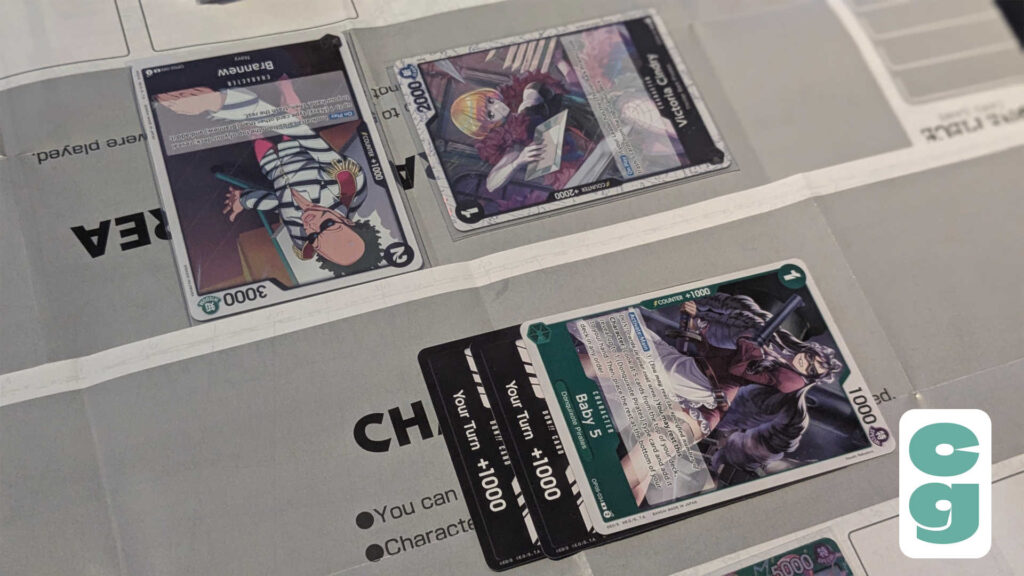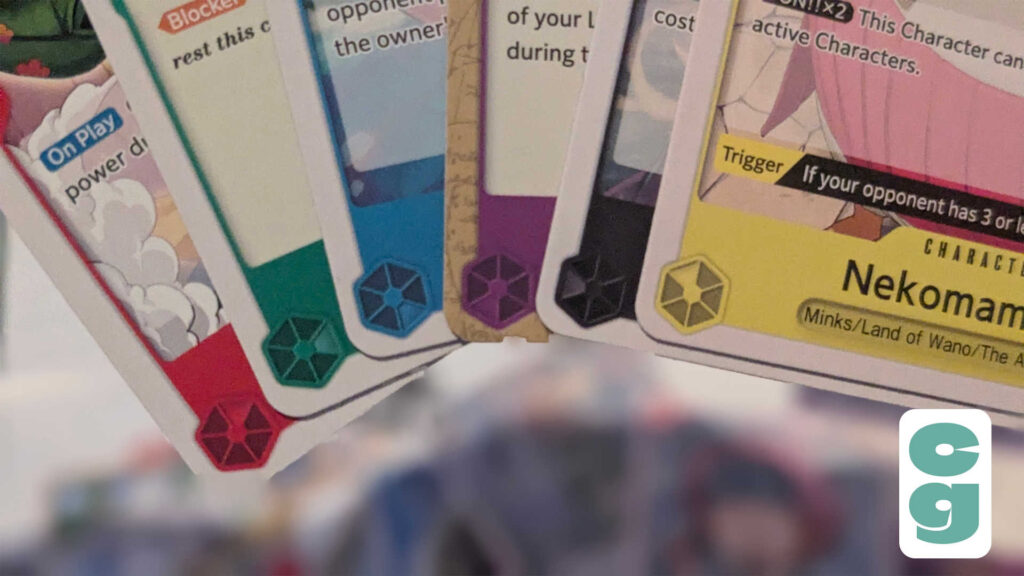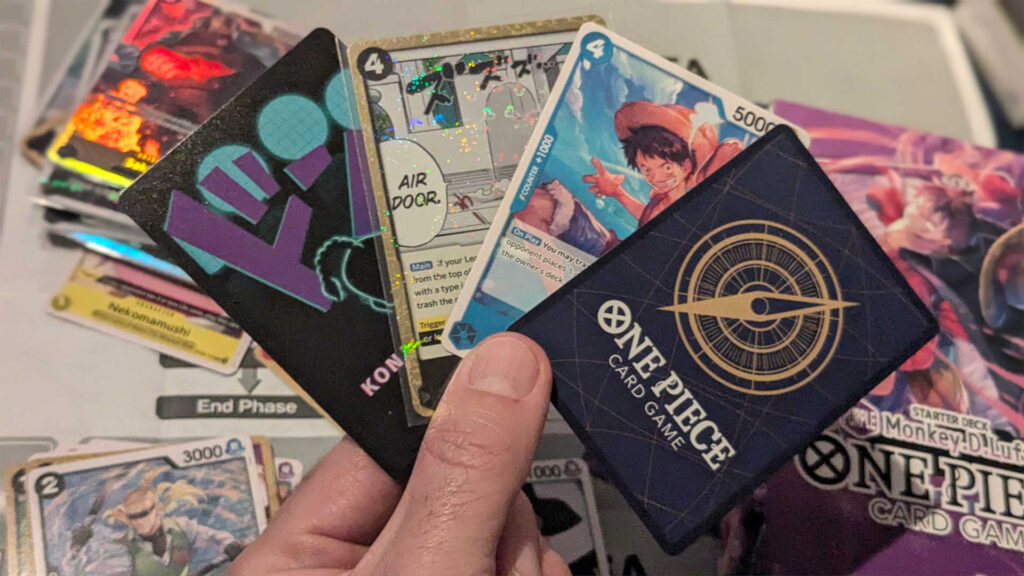As it’s been around since the ’90s, the manga and anime saga, One Piece (which has also been adapted into live action, thanks to Netflix), has managed to become a real pop culture staple, which everyone seems to have heard of, whether or not they’ve seen or read any of the story itself. It’s odd, then, that it took until 2022 for the One Piece Card Game to be released (though there was a previous One Piece Collectible Card Game in 2003, which was very short-lived), but it’s proven pretty popular and seems to have found quite a dedicated fanbase, of both players and collectors of the game’s beautiful cards.
Though it’s fairly straightforward to learn how to play the One Piece Card Game, it’s very easy to miss certain rules in your first few games. So let’s take a look at all of the basics!
Table of Contents
ToggleGetting Started With the One Piece Card Game
Though we’ve covered this briefly in our guide to the best beginner sets for the most popular card games, the best way to get started with the One Piece Card Game is with a starter deck. The game’s decks are made up of cards which are specific colors; which colors you can use depend on the deck’s Leader card. Most Leaders have just one color, but some have two; we recommend starting with a Leader card that has just one color.

As to which one to choose; while you’re learning, it’s not all that important which deck you pick as your first. If you’re a One Piece fan already, it’s best to choose a deck headed up by your favorite character as the Leader.
Each starter deck contains a Leader, a main draw deck (of 50 cards) and a deck of 10 DON!! cards (more on those shortly). There’s also a play mat, which has a really useful rules summary on the reverse; however, it’s from using this that a few important rules are easily missed. Setting up the game is just a case of each player placing their Leader card in their space, the DON!! deck in its own designated area and shuffling their own main deck, then drawing five cards.

Each player checks their Leader card to find their Life value, then places a number of cards equal to that value in their own Life area on the playfield; for example, the Monkey D. Luffy Leader card shown above has five Life, so would have five cards dealt to his Life area. The first player (chosen at random, with the rules suggesting rock, paper, scissors as a method) then begins their first turn.
Turns in the One Piece Card Game
Each player will carry out all phases of their turn in order, before play passes to their opponent.
The phases are named as follows:
- Refresh Phase
- Draw Phase
- DON!! Phase
- Main Phase
- End Phase
The object of the game in One Piece is to successfully attack your opponent’s Leader when they have no Life cards left to draw. Players will play cards from their hand, using DON!! cards to pay for them, and will attack Leaders and other Characters using their own cards, in the hope of being strong enough to make the opponent draw cards from their Life area until they have none left to draw.
Let’s take a look at how this works in practice, with an overview of each of the phases.
Refresh Phase

In this phase, which will be skipped on the first turn, players will return all attached DON!! cards from their field to their DON!! cost area, as well as setting all rested cards to active. Cards are rested, or turned sideways (which is the same thing as tapping in Magic: The Gathering, exerting in Disney Lorcana, or exhausting in Star Wars Unlimited) during a turn, when attacking or performing certain actions, and they remain this way until the beginning of your next turn, during the refresh phase. In the image above, the Baby 5 card is rested, and will be turned active, like the Capone “Gang” Bege card, during the Refresh Phase.
Draw Phase
During the Draw Phase, players will simply draw a card from the top of their main deck. Note that the first player doesn’t get to do this on their first turn!
DON!! Phase

In the DON!! Phase, you simply turn over the top two cards of your DON!! deck, and place them face up in the cost area, with any others you’ve already done the same with on previous turns; they accumulate at the rate of two per turn, unless a card effect allows otherwise. Note that the first player also has a penalty here on their very first turn: they only place one DON!! card on their first turn, but on every other turn, two DON!! cards are placed.
Main Phase

Here’s where the action happens, and it’ll be familiar to players of just about any other trading card game. During the main phase, players have a choice of actions, and may perform them in any order, as many times as they want, or as their hand or DON!! cards allow. The actions they may perform are as follows:
- Play a card – players may play a card from their hand, which has a cost in the top left corner (the Emporio.Ivankov card shown above has a cost of 5). This is how many DON!! cards must be rested in order to play the card. If you don’t have enough active DON!! cards, or not enough DON!! cards in your play area to pay a card’s cost, you can’t play it yet. Cards you can play from your hand include Characters, Events, and Stages. Characters are played into the Character area (and cannot be used to attack on their first turn in play), the text on Event cards is followed, and then the card is discarded (or trashed, in One Piece Card Game terminology), and finally, Stage cards are played and stay in play next to the Leader, unless a card effect removes them.
- Attach DON!! cards – players can move DON!! cards from their cost area and attach them to a Character or Leader; each DON!! card attached to another card gives a +1000 Power bonus. There are a few rules around attaching DON!! cards which tend to be missed; multiple DON!! cards may be attached to any one Character, and the +1000 Power bonus per card only applies on the current turn, not on the opponent’s next turn.
- Use a card’s effect – Some Leader or Character cards have effects that can be carried out during the main phase; sometimes these have a cost. A black box with “DON!!x1” means that the ability can be used if one DON!! card is attached. “DON!!-1” means that one DON!! card must be returned from the field to your DON!! deck to use it. Finally, a blue box which says “Activate (Main) 1” can be used if you rest one DON!! card in the cost area. Two examples can be seen below; the Dracule Mihawk card has a DON!!x1 ability, and the Vinsmoke Niji has a DON!!-1 ability.

There’s one more option when it comes to actions that can be taken during the Main Phase: attack. As this has its own flow of play, let’s take a look at it in a bit more detail than the other options.
Attack
Though attacking is an option carried out during the Main Phase, it has its own subset of steps. Once these are carried out, a player will resume their Main Phase. Let’s take a look at each step.

Attack Step
In order to attack, players must choose which of their Characters they’ll attack with, or they can attack with their Leader. This character is then rested (so again, this just turning the card 90 degrees) and a target is declared.
The opponent’s Leader may be attacked, or an opponent’s Character which is rested. This is another rule that’s easy to miss; a player may not attack an active Character, only a rested Character or a Leader (a Leader can be attacked even if it is rested). In the above example, the Baby 5 card is resting in order to attack. The only Character on the opponent’s side they can attack is Victoria Cindry, as she’s rested; Brannew is active, so is not a legal target.
Block Step

The player being attacked may use a Blocker ability on one of their cards, if they have the Blocker keyword (as shown in the above image). This makes the card with the Blocker ability the target of the attack, rather than the one that the attacker declared.
Counter Step

Some cards have a Counter value, printed vertically on their left side; players can choose to play one of these cards from their hand, which doesn’t have a DON!! cost. The Counter value is then added to the defending card’s Power. In the example above, the card shown has a Counter value of +2000, which would be added to the defending card’s Power.
Damage Step
Finally, the damage step takes place. Here’s where you determine whether an attack is successful or not The Power values of each card, printed in the top right, are compared. Any Counter values or attached DON!! cards are also taken into account for each card to get their final Power total. The attacking card wins if its total Power is equal to or higher than the total Power of the defending card.
If a Leader is attacked and the attacker wins, the defending player must draw one card from their Life area. If they have no Life cards left to draw at this point, the attacker wins the game. If a Leader is attacked and the defender wins, the attacking player must draw one Life card from their Life area.

If a Character is attacked and the attacker wins, the defending Character is trashed. If a Character is attacked and the defending Character wins, nothing happens.
Using the example in the image above, Baby 5 is attacking, with two DON!! cards attached. Though Baby 5’s printed Power value is 1000, the DON!! cards add +2000 Power, giving her a total of 3000 Power. Victoria Chandry’s Power is 2000, so loses the attack, and will be trashed.
Then play returns to the Main Phase, where the current player can perform further actions until they cannot, or do not want to, perform any more.
End Phase
Finally, there’s the End Phase; here, any card effects which state “during this turn” are ended, and any Main Phase card effects can no longer be used. Play then passes to the next player, who begins their turn at the Refresh Phase.
Are There More Rules to the One Piece Card Game?
Though what we’ve already gone through, step by step, are the basic rules, there are different keywords and abilities on certain cards which may add a certain layer of complexity or allow for different strategies and synergies during play. These will become clearer once you’ve played a few rounds with your deck, or find cards with these effects to use; they’re generally easy to understand and use, just by referring to the card’s text.
Can I Build My Own One Piece Card Game Decks?

One of the joys of any trading card game or collectible card game (also known as TCGs and CCGs) is that you can collect cards and build your own decks from them. There are rules around deck building to be aware of; firstly, you’ll need a Leader card, and you can only use cards in your deck which have the same color as your Leader card (see all of the six card colors shown above, as they appear on each card). Leader cards have a red back, and can be either single or dual colored on their front.

You’ll also need 10 DON!! cards; though these will sometimes have different artwork or designs, they will have a white back and will always each give +1000 Power, or provide one DON!! card of cost for the purposes of playing cards.
Then there’s the deck of cards as your main deck; these have a dark blue back and must all be the same color (or colors) as your Leader card. These will be your Character, Event, and Stage cards to be used over the course of the game.
Which One Piece Booster Packs Should I Buy?

Each starter deck you’ll find for sale is packaged with a single booster pack, and currently this is most likely to be the Premium Booster pack from the set named The Best.
This set offers reprints from many prior One Piece Card Game sets, some with new artwork, alongside a few new cards too. What’s cool about these booster packs is that they give you a great variety of cards from across the game’s (admittedly fairly brief) history, with many of the most popular cards included.
Of course, other sets are available, with each of them generally based on a specific arc from the One Piece saga. And if you have a favorite storyline or set of characters who appeared in a specific arc, there’s nothing wrong with checking out a specific booster pack from a set that catches your eye!
Want more One Piece content? Why not check out our list of the One Piece Card Game card types, and our guide to the One Piece Card Game‘s card rarities?





